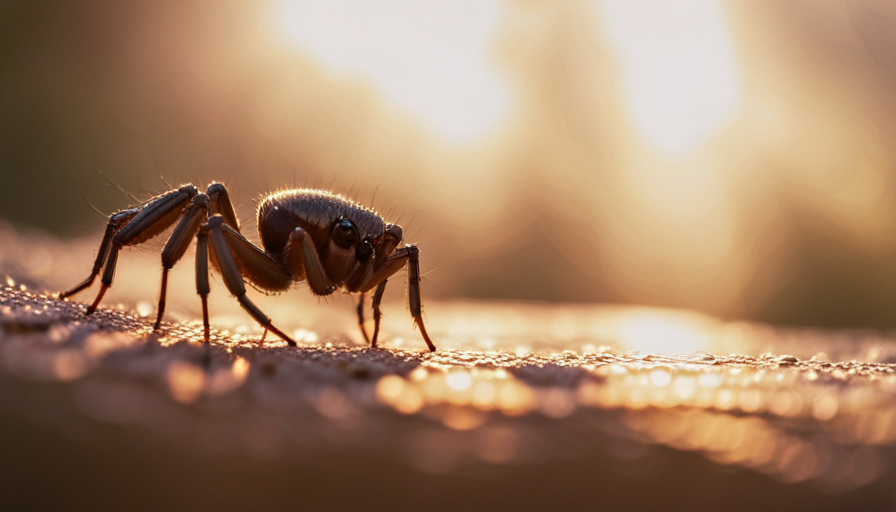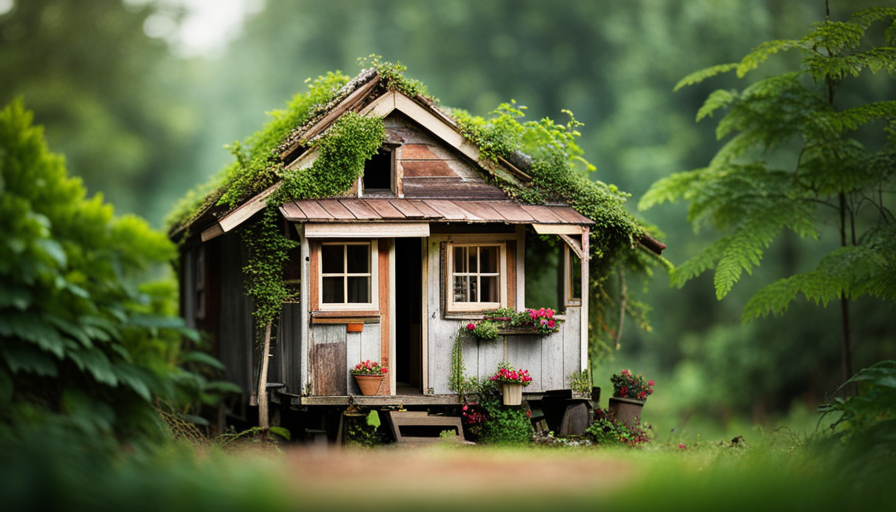How long do small house spiders typically live?
The answer to this question can be fascinating, as these eight-legged creatures have a remarkable ability to adapt and thrive in a variety of environments. Understanding the lifespan of house spiders is essential for homeowners who want to coexist peacefully with these tiny arachnids.
In my research on the subject, I have discovered that the lifespan of house spiders can vary depending on several factors. Factors such as species, environmental conditions, and reproductive activity all play a role in determining how long these spiders live.
So, what are some common species of house spiders and how long do they typically live? How does reproduction affect their lifespan? And what can we do to prevent these spiders from entering our homes?
In this article, we will delve into these questions and more, providing you with the knowledge you need to better understand and live harmoniously with these fascinating creatures.
Key Takeaways
- House spiders have varying lifespans depending on the species, with the black widow and American house spider living for about 1 year, the jumping spider for 2 years, the cobweb spider for up to 3 years, and the orb-weaving spider for 1-2 years.
- Female house spiders generally live longer than males due to their investment in reproduction, with some females reaching up to five years or more.
- Factors such as temperature, humidity, availability of food, and exposure to predators can greatly impact the lifespan of house spiders.
- Human activities like pollution and climate change can negatively affect house spider lifespan, with pollution causing respiratory problems and reduced reproductive success, and climate change posing threats with extreme temperatures and changes in precipitation.
A Look into the Life Cycle of House Spiders
Take a closer look into the fascinating life cycle of those eight-legged creatures that creep and crawl through our homes. House spiders, also known as tiny house spiders, have a unique life cycle that consists of several stages.
From egg to adult, these spiders go through a series of transformations that are influenced by various factors affecting their longevity.
House spiders typically lay their eggs in protected areas, such as corners, crevices, or underneath furniture. The eggs hatch into spiderlings, which undergo molting several times before reaching adulthood. The entire process can take several months, depending on the species and environmental conditions.
Behavior patterns in house spiders also play a role in their lifespan. Some species are more active and adventurous, while others prefer to stay in their webs and wait for prey. These behavior patterns can impact their ability to find food, avoid predators, and mate, ultimately affecting their overall lifespan.
Factors that affect the lifespan of house spiders include temperature, humidity, availability of food, and exposure to predators. Higher temperatures and humidity levels can promote faster growth and development, while a lack of food or constant threat from predators can shorten their lifespan.
In the subsequent section, we will explore the various factors that affect the lifespan of house spiders, including environmental conditions and natural predators.
Factors That Affect the Lifespan of House Spiders
One fascinating statistic to consider is the impact of environmental conditions on the lifespan of these arachnids. Factors influencing spider longevity include a variety of environmental factors such as temperature, humidity, and access to food and water. Environmental conditions play a crucial role in determining the lifespan of house spiders, as they can either extend or shorten their life expectancy.
To further understand the relationship between environmental conditions and spider lifespan, let’s examine the following table:
| Environmental Condition | Effect on Spider Lifespan |
|---|---|
| High temperature | Shortens lifespan |
| Low temperature | Lengthens lifespan |
| High humidity | Lengthens lifespan |
| Low humidity | Shortens lifespan |
| Abundant food/water | Lengthens lifespan |
| Limited food/water | Shortens lifespan |
As seen in the table, high temperatures and low humidity tend to shorten the lifespan of house spiders. On the other hand, low temperatures and high humidity contribute to a longer lifespan. Additionally, an abundant supply of food and water can also extend the life expectancy of house spiders.
Understanding these factors can help us better comprehend the complexities of spider lifespan and their ability to adapt to various environments. Transitioning to the subsequent section about common species of house spiders and their lifespan, it is important to consider how these factors interact with the life cycle of different spider species.
Common Species of House Spiders and Their Lifespan
Explore the fascinating world of house spider species and discover how their lifespans vary based on environmental factors. House spiders, like the common cellar spider (Pholcus phalangioides), can live for up to two years. However, there are other species that have shorter lifespans, such as the black widow (Latrodectus spp.), which typically lives for about one year.
To paint a picture of the diversity of house spider species and their lifespans, here are five examples:
-
The American house spider (Parasteatoda tepidariorum) has a lifespan of about one year.
-
The jumping spider (Salticidae spp.) has a lifespan of about two years.
-
The cobweb spider (Theridiidae spp.) can live for up to three years.
-
The orb-weaving spider (Araneidae spp.) has a lifespan of about one to two years.
-
The cellar spider (Pholcidae spp.) can live for up to two years.
House spiders go through various life cycle stages, including egg, spiderling, juvenile, and adult. During these stages, they exhibit different behavior patterns, such as building webs, hunting prey, and mating. These behaviors, along with environmental factors like temperature and food availability, can influence the lifespan of house spiders.
Understanding the life cycle stages and behavior patterns of house spiders is crucial in comprehending the role of reproduction in their lifespan. Transitioning into the next section, we will explore how reproduction impacts the overall lifespan of these fascinating creatures.
The Role of Reproduction in the Lifespan of House Spiders
Immerse yourself in the intricate web of the house spider’s life as reproduction weaves a thread that determines their fleeting existence. The role of reproduction plays a crucial part in the lifespan of house spiders, as it greatly influences their longevity.
Female house spiders typically have a longer lifespan compared to their male counterparts. This is due to the fact that females invest more energy into reproduction, from producing eggs to caring for their young. In contrast, males focus their energy on finding mates and are often consumed by the female after mating.
Reproduction’s influence on spider longevity can be seen in the lifespan variations among male and female house spiders. Female house spiders can live for several years, with some reaching up to five years or more. In contrast, male house spiders have a much shorter lifespan, typically living for only a few months. This difference in lifespan is a result of the reproductive strategies employed by each sex.
As we delve deeper into the intricacies of house spider lifespan, we will explore the fascinating variations between male and female spiders in terms of their lifespan and reproductive behaviors.
Lifespan Variations among Male and Female House Spiders
Reproduction greatly impacts the lifespan of male and female house spiders, leading to significant variations in their longevity. Lifespan differences between male and female house spiders can be attributed to their distinct mating behaviors. Here are three key factors that contribute to the variations in lifespan among male and female house spiders:
-
Mating Behavior: The act of mating can be a perilous endeavor for male house spiders. They engage in elaborate courtship rituals and often risk their lives to find a suitable mate. Once copulation is achieved, males are more likely to die shortly after, as the female may cannibalize them for nutrients. On the other hand, female house spiders have the advantage of being able to mate multiple times without suffering the same fate.
-
Reproductive Investment: Female house spiders invest a significant amount of energy into producing eggs and caring for their offspring. This investment can take a toll on their overall health and lifespan. In contrast, male house spiders do not contribute to parental care, allowing them to allocate more energy towards survival.
-
Hormonal Changes: The reproductive process triggers hormonal changes in both male and female house spiders. These changes can have profound effects on their physiology and behavior, potentially influencing their lifespan.
Understanding these lifespan differences and the underlying mating behaviors of house spiders provides valuable insights into their biology.
Transitioning into the subsequent section about the impact of human activities on house spider lifespan, it is crucial to consider how our actions may further affect these intricate dynamics.
The Impact of Human Activities on House Spider Lifespan
In the previous subtopic, we explored the lifespan variations between male and female house spiders. Now, let’s delve into the impact of human activities on the lifespan of these fascinating arachnids.
Human activities, such as pollution and climate change, have a profound effect on the lifespan of house spiders. Pollution, especially air pollution, can lead to respiratory problems and reduced reproductive success in spiders. Additionally, exposure to pollutants in their environment can weaken their immune system, making them more susceptible to diseases and reducing their overall lifespan.
Climate change also poses a threat to house spider longevity. As temperatures rise and weather patterns become more unpredictable, spiders may struggle to adapt. Extreme heat or cold can be fatal to spiders, and changes in precipitation can disrupt their food sources, leading to starvation.
To illustrate the impact of human activities on house spider lifespan, consider the following table:
| Human Activity | Impact on Lifespan |
|---|---|
| Pollution | Reduced |
| Climate Change | Decreased |
These factors highlight the importance of understanding and mitigating the negative effects of human actions on our environment and its inhabitants. Now, let’s explore ways to prevent house spiders from entering your home.
Ways to Prevent House Spiders from Entering Your Home
To keep these fascinating arachnids out of your home, try implementing these simple tips to prevent house spiders from entering.
-
Seal cracks and crevices: House spiders can squeeze through tiny openings, so it’s important to seal any gaps in windows, doors, and walls. Use caulk or weatherstripping to ensure a tight seal.
-
Keep a tidy home: Spiders are attracted to clutter and dark hiding spots. Regularly declutter and clean your home to eliminate hiding places for spiders. Vacuum regularly, especially in corners and under furniture.
-
Use natural spider repellents: Certain scents are known to repel spiders. Try using essential oils like peppermint, lavender, or tea tree oil to deter them. Simply mix a few drops with water in a spray bottle and apply to areas where spiders are likely to enter.
By following these preventive measures, you can greatly reduce the chances of house spiders invading your home. However, if you already have a spider problem, you may need to employ natural methods to control house spider populations. These methods focus on minimizing their preferred habitats and disrupting their reproductive cycle, which I will discuss in the next section.
Natural Methods to Control House Spider Populations
After learning about the various ways to prevent house spiders from entering your home, it’s important to consider natural methods for controlling their populations. These remedies are not only effective but also safe for both humans and the environment.
One natural spider deterrent is the use of essential oils, such as peppermint, tea tree, and lavender. Spiders are known to dislike these scents, so spraying a diluted mixture of these oils around windows, doors, and other entry points can discourage them from entering your home.
Additionally, keeping your home clean and clutter-free is essential, as spiders are attracted to dark and dusty areas. Regularly vacuuming and dusting can help eliminate potential hiding spots for these arachnids.
Another effective method is the use of spider traps, which can be easily made at home using common household items. Placing these traps along walls, corners, and other areas where spiders are commonly found can help capture and remove them from your living space.
By incorporating these natural remedies and spider deterrents into your home maintenance routine, you can significantly reduce the population of house spiders. However, it’s important to remember that these methods aren’t foolproof and may not completely eliminate the presence of spiders in your home.
Transitioning into the subsequent section about misconceptions and myths about house spider lifespan, it’s crucial to address the common belief that house spiders live for an extended period of time.
Misconceptions and Myths about House Spider Lifespan
Contrary to popular belief, there’s a misconception surrounding the lifespan of those eight-legged creatures commonly found in our homes. Many people believe that house spiders have a short lifespan, lasting only a few months or a year at most. However, this is a myth that needs to be debunked.
House spiders can actually live for several years if the conditions are right. Understanding the life span of house spiders is crucial for living harmoniously with them. These arachnids typically reach maturity within a year and can live for an additional two to three years. Factors such as temperature, food availability, and habitat conditions can significantly affect their lifespan. In optimal conditions, some house spiders have been known to live up to five years.
It is important to note that the lifespan of house spiders can vary depending on the species. While some species may have shorter lifespans, others can live longer. Additionally, male house spiders generally have shorter lifespans compared to females. This is because males often die shortly after mating, while females can live longer to lay multiple egg sacs.
By understanding the true lifespan of house spiders, we can appreciate their presence in our homes and learn to coexist with them.
In the next section, I will share tips for living harmoniously with these fascinating creatures, allowing us to maintain a balanced ecosystem within our living spaces.
Tips for Living Harmoniously with House Spiders
Here’s how you can peacefully coexist with these fascinating arachnids in your home. Creating a spider-friendly home is essential if you want to live harmoniously with house spiders.
First and foremost, it’s important to understand that house spiders play a crucial role in controlling other pests, such as flies and mosquitoes. So, instead of trying to eliminate them completely, consider allowing them to thrive in your space.
To make your home spider-friendly, start by reducing clutter and keeping your living areas clean. Spiders are attracted to dark, undisturbed spaces, so decluttering will limit their hiding spots. Regularly dust and vacuum to remove any spider webs or egg sacs.
Additionally, seal any cracks or gaps in windows and doors to prevent spiders from entering your home.
Another helpful tip is to minimize the use of pesticides, as these can harm not only spiders but also the ecosystem as a whole. Instead, opt for natural alternatives like vinegar or essential oils to repel spiders without causing harm.
Lastly, providing alternative habitats for spiders can divert their attention away from high-traffic areas. Consider placing small, inconspicuous spider homes, like empty containers or cardboard tubes, in corners or behind furniture.
By following these tips, you can create a spider-friendly environment and peacefully coexist with these beneficial creatures in your home.
Frequently Asked Questions
Are house spiders dangerous to humans?
House spiders, oh how terrifying they are! With their eight legs and beady little eyes, one might think they’re venomous creatures waiting to pounce. But fear not, dear reader, for I’m here to assure you that house spiders aren’t dangerous to humans.
While they may bite if threatened, their venom is usually harmless and causes only minor irritation. So rest easy, knowing that these tiny arachnids pose no real danger to our well-being.
What is the average lifespan of a house spider?
The average lifespan of a house spider can vary depending on several factors. These factors include environmental conditions, availability of food, and predation. On average, house spiders can live for about one to two years. However, some species can live for several years under favorable conditions.
It’s important to note that the lifespan of individual house spiders can be greatly influenced by their surroundings, making it difficult to determine an exact lifespan for all species.
Can house spiders survive in extreme temperatures?
Alright folks, let me tell you about house spiders and their ability to handle extreme temperatures. Now, you might think these little critters would struggle in harsh conditions, but let me assure you, they have some nifty adaptations up their eight-legged sleeves.
House spiders are known to possess thermoregulatory mechanisms that help them survive both hot and cold environments. These adaptations allow them to withstand a wide range of temperatures, making them quite the resilient arachnids.
How many eggs do house spiders typically lay in their lifetime?
House spider reproduction is a fascinating process. Female house spiders typically lay multiple egg sacs in their lifetime, each containing around 100-400 eggs. These sacs are carefully constructed and protected by the spider until the eggs hatch. The number of egg sacs produced by a female house spider can vary depending on factors such as species, age, and environmental conditions.
House spider egg sacs play an important role in ensuring the survival and continuation of their species.
Do house spiders have any natural predators?
House spiders have several natural predators, including birds, lizards, and other spiders. However, one interesting statistic is that roughly 95% of their predators are actually other spiders.
House spiders feed on a variety of insects, including flies, mosquitoes, and other small arthropods. They are known for their ability to spin intricate webs, which they use to catch their prey. These webs serve as both their hunting ground and their home, providing them with shelter and a steady source of food.
Conclusion
In conclusion, understanding the lifespan of house spiders is crucial for effective pest management. One interesting statistic to note is that the average lifespan of a house spider can range from one to two years, depending on various factors such as species, environmental conditions, and reproductive cycles.
This visual representation highlights the importance of implementing preventive measures to control house spider populations and mitigate their impact on our homes. By adopting natural methods and debunking misconceptions, we can coexist harmoniously with these fascinating creatures while maintaining a spider-free environment.
Hi, I’m Emma. I’m the Editor in Chief of Tiny House 43, a blog all about tiny houses. While tree houses are often associated with childhood, they can be the perfect adult retreat. They offer a cozy space to relax and unwind, surrounded by nature. And since they’re typically built on stilts or raised platforms, they offer stunning views that traditional homes simply can’t match. If you’re looking for a unique and romantic getaway, a tree house tiny house might just be the perfect option.









